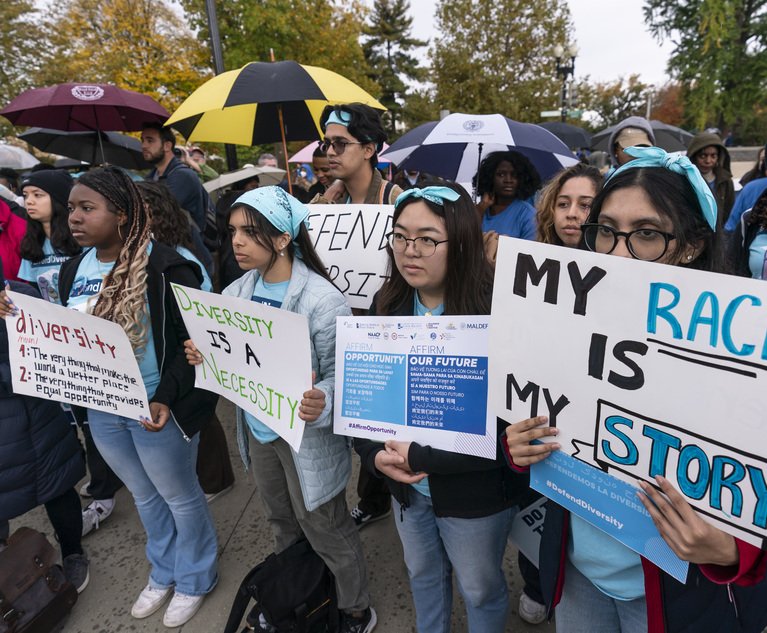 Harvard student, Samaga Pokharel, right, and other activists rally as the Supreme Court hears oral arguments on a pair of cases that could decide the future of affirmative action in college admissions, in Washington, Monday, Oct. 31, 2022. Photo: J. Scott Applewhite/AP
Harvard student, Samaga Pokharel, right, and other activists rally as the Supreme Court hears oral arguments on a pair of cases that could decide the future of affirmative action in college admissions, in Washington, Monday, Oct. 31, 2022. Photo: J. Scott Applewhite/AP What Law Firm Diversity Professionals Should Do In Immediate Wake of SCOTUS Affirmative Action Ruling
Amie Santos, a recent diversity director at an Am Law 100 firm, discusses how law firms can act fast to reaffirm their diversity efforts.
June 29, 2023 at 11:23 AM
4 minute read
The original version of this story was published on The American Lawyer
Affirmative action is over, but equity efforts are far from defeated. While the Supreme Court's ruling was heavily predicted and there is no roadmap for what follows, we have never had a roadmap to guide organizational efforts around diversity, equity and inclusion. What we do have is enough knowledge from preceding events to know that enrollment of historically excluded students drastically drops when race is no longer considered as a component of the college admissions process. This played out in California and Michigan respectively after state referendums and ballot initiatives in 1996 and 2006. We also have enough knowledge and data around the DEI market to know that organizational commitment waxes and wanes based on changing economic and political climates. But most importantly, we have learned that diversity is and will remain a positive differentiator. The research and benefits harnessed over the past decades will not disappear with one court ruling.
As a leader, it is important to center your diversity management strategy around a few key tenants:
- More diverse leadership teams will continue to drive stronger business outcomes—as countless studies have proven.
- Clients will continue to make hiring and firing decisions based on firms presenting diverse teams, highlighting inclusive cultures and operating socially engaged operations that are aware of and involved in issues surrounding their communities and industry.
- Talent will continue to seek employers that align with their personal values and missions—and hold firms to account that fail.
- More diverse workplaces are inevitable.
The end of affirmative action may prove challenging for leaders dedicated to the difficult task of creating and upholding equitable cultures. There will be more lawsuits. Already under-represented racially diverse talent in law schools will decline. Anti-DEI proponents will become even more emboldened. Even taking all the headwinds into consideration, now is the time to double down. Tactics will need to change in some functions, but the overall objective of building more diverse and inclusive organizations remains. Some firms will pull ahead, while others will falter in their commitment. As you move forward, consider engaging in the following:
- Publicly reiterate your commitment to building an equitable organization. Many of your employees will be worried that the ruling will result in disengagement from leadership on diversity efforts.
- Prioritize expanding recruiting efforts to include earlier pipeline programs that extend beyond law school preparation and law school. The legal industry will need to reach deeper, similar to investments in young diverse talent in the STEM sector through secondary education outreach.
- Increase investment and partnerships with universities and law schools known to attract more diverse populations, starting with HBCU's where endowments and resources run smaller.
- As employers of graduating talent, apply pressure to elite law schools to end other preferential admissions policies for other groups. This includes legacy students, children of large donors and athletes.
- Broaden diversity efforts to include socio-economic status. There is a high correlation between historically excluded racially diverse talent in law schools and those with limited economic means.
Lawyers will continue to solve some of the world's most challenging problems. The profession is up for the challenge of continuing to drive equitable representation within our own walls.
This content has been archived. It is available through our partners, LexisNexis® and Bloomberg Law.
To view this content, please continue to their sites.
Not a Lexis Subscriber?
Subscribe Now
Not a Bloomberg Law Subscriber?
Subscribe Now
NOT FOR REPRINT
© 2025 ALM Global, LLC, All Rights Reserved. Request academic re-use from www.copyright.com. All other uses, submit a request to [email protected]. For more information visit Asset & Logo Licensing.
You Might Like
View All
Trump Seeks Pause of Supreme Court Cases, Disavows DOJ Stance on Voting Rights Act

Poop-Themed Dog Toy OK as Parody, but Still Tarnished Jack Daniel’s Brand, Court Says
4 minute read
Supreme Court Reinstates Corporate Disclosure Law Pending Challenge

Justices Grill US Government in Venue Dispute Over FDA Vape Challenges
Trending Stories
Who Got The Work
J. Brugh Lower of Gibbons has entered an appearance for industrial equipment supplier Devco Corporation in a pending trademark infringement lawsuit. The suit, accusing the defendant of selling knock-off Graco products, was filed Dec. 18 in New Jersey District Court by Rivkin Radler on behalf of Graco Inc. and Graco Minnesota. The case, assigned to U.S. District Judge Zahid N. Quraishi, is 3:24-cv-11294, Graco Inc. et al v. Devco Corporation.
Who Got The Work
Rebecca Maller-Stein and Kent A. Yalowitz of Arnold & Porter Kaye Scholer have entered their appearances for Hanaco Venture Capital and its executives, Lior Prosor and David Frankel, in a pending securities lawsuit. The action, filed on Dec. 24 in New York Southern District Court by Zell, Aron & Co. on behalf of Goldeneye Advisors, accuses the defendants of negligently and fraudulently managing the plaintiff's $1 million investment. The case, assigned to U.S. District Judge Vernon S. Broderick, is 1:24-cv-09918, Goldeneye Advisors, LLC v. Hanaco Venture Capital, Ltd. et al.
Who Got The Work
Attorneys from A&O Shearman has stepped in as defense counsel for Toronto-Dominion Bank and other defendants in a pending securities class action. The suit, filed Dec. 11 in New York Southern District Court by Bleichmar Fonti & Auld, accuses the defendants of concealing the bank's 'pervasive' deficiencies in regards to its compliance with the Bank Secrecy Act and the quality of its anti-money laundering controls. The case, assigned to U.S. District Judge Arun Subramanian, is 1:24-cv-09445, Gonzalez v. The Toronto-Dominion Bank et al.
Who Got The Work
Crown Castle International, a Pennsylvania company providing shared communications infrastructure, has turned to Luke D. Wolf of Gordon Rees Scully Mansukhani to fend off a pending breach-of-contract lawsuit. The court action, filed Nov. 25 in Michigan Eastern District Court by Hooper Hathaway PC on behalf of The Town Residences LLC, accuses Crown Castle of failing to transfer approximately $30,000 in utility payments from T-Mobile in breach of a roof-top lease and assignment agreement. The case, assigned to U.S. District Judge Susan K. Declercq, is 2:24-cv-13131, The Town Residences LLC v. T-Mobile US, Inc. et al.
Who Got The Work
Wilfred P. Coronato and Daniel M. Schwartz of McCarter & English have stepped in as defense counsel to Electrolux Home Products Inc. in a pending product liability lawsuit. The court action, filed Nov. 26 in New York Eastern District Court by Poulos Lopiccolo PC and Nagel Rice LLP on behalf of David Stern, alleges that the defendant's refrigerators’ drawers and shelving repeatedly break and fall apart within months after purchase. The case, assigned to U.S. District Judge Joan M. Azrack, is 2:24-cv-08204, Stern v. Electrolux Home Products, Inc.
Featured Firms
Law Offices of Gary Martin Hays & Associates, P.C.
(470) 294-1674
Law Offices of Mark E. Salomone
(857) 444-6468
Smith & Hassler
(713) 739-1250








